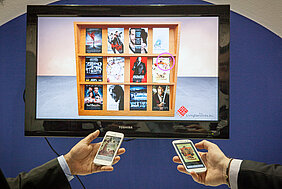Semantic Mobile Interaction, SMI, provides a new way to support simultaneous multi-user interaction with physical objects in the environment, as well as 2D and 3D representations of objects that are displayed by flat panels, projectors, billboards and posters, using unmodified mobile devices.
“The SMI technology unleashes new ways of mobile interaction, shopping and advertising”, says Prof. Zary Segall, the project leader. “It provides a superior user experience by semantically associating mobile digital content with objects in the physical space. SMI based interaction has the immediate potential to improve the mobile user experience while providing new business models for the Telco ecosystem and mobile advertising and shopping.”
The basic research for SMI has been performed at the Mobile Services Lab at KTH Royal Institute of Technology in Stockholm with support from the Swedish Agency for Innovation, Vinnova. As part of the EIT ICT Labs Action Line Smart Spaces the inventors received support for marketing and dissemination of the SMI technology, and for developing and validating various business models associated with SMI.
“SMI technology has a large application potential”, says Willem Jonker, CEO of EIT ICT Labs. “It allows the transformation of any screen and virtually any surface into a multi-interaction screen where the touch is performed through mobile devices and rich content is consumed on personal screens.”
A demonstration of Semantic Mobile Interaction was shown for the first time at MWC 2013. With SMI, any surface can become a Digital-shop or an interactive advertising media. By using the mobile terminal to interact with objects or images displayed on the surface, users could gain access to information or directly purchase digital goods. This is a novel, playful and potentially superior mobile user experience for interactive mobile advertising and shopping.
The SMI technology facilitates innovative marketing allowing direct distribution of digital content to mobile devices by using existing marketing media, including paper, posters and billboards, without the proximity requirement of NFC, image recognition or QR codes. Users may interact with the marketing images and easily access e.g. video, audio, web, and share the content on major social networks such as Facebook, Instagram, Pinterest and Twitter.
EIT ICT Labs presents Semantic Mobile Interaction technology at MWC







